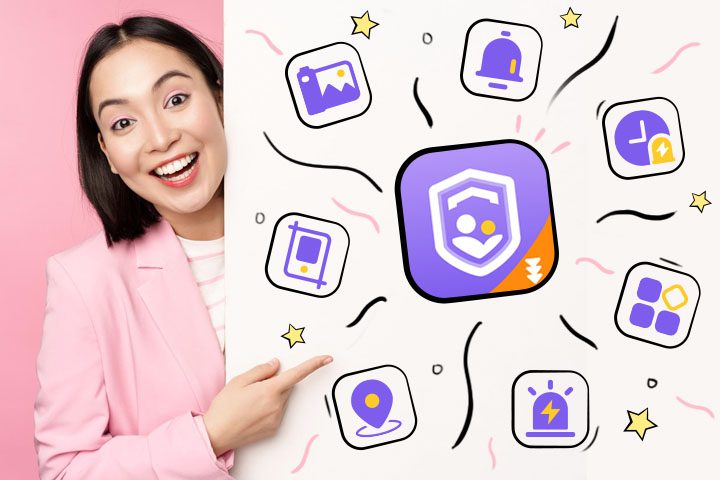As parents, you are constantly worried when your teens are attracted to numerous apps/websites that keep you guessing what is happening in their lives. One such platform that has caught their attention recently is Character AI. It is the implementation detail of AI, often called c.ai. However, the question remains whether or not c.ai is safe to use. It can be a little dangerous, but teenagers prefer to use it more than any other tool. In this blog post, we will go in-depth on this Character AI. What is c.ai? How old do you need to be to use it? Is c.ai safe for children and teens? So, read along if you’re unsure about letting your teen use this platform.
What is Character AI?
C.ai is the world’s most cutting-edge AI platform connecting people to interactive characters using artificial intelligence. These characters can talk, perform role-play skits, and can even mimic human-like interactions. It’s a chatbot that can adapt and respond accordingly depending on what you feed it. This adaptability makes c.ai an intriguing resource for kids and can also be a great tool to tinker with creative writing, storytelling, or even some kind of digital interaction. c.ai is arguably the most engaging and creative tool for some teens who think outside of the box.



In addition to pre-designed characters, users can also create their own from scratch with a large number of options. The characters range from history to fiction or even new ones created entirely by the user. This is a massive selling point of c.ai because the possibilities are virtually endless. Teens might explore making their favorite book characters come alive, practice conversation with historical figures, or construct a character that embodies some part of themselves and their life experiences.
While this is not what c.ai is all about, it has a lot to do with the interaction between these characters. It employs sophisticated natural language processing algorithms to make the dialogue with these characters more life-like and interesting. Every time the AI interacts with a user, it learns more about their likes, dislikes & preferences. It also picks up on conversational style as well to get you the perfect experience. For teenagers, that can be entertaining and fruitful to the intellect.
What is the age limit for c.ai?
As parents, we regularly use age limits as the main determinant of whether or not to let our children access a new digital service. Character. ai is no exception. Although the platform does not say a specific age that you must be, it is recommended for 16+. The digital world is vast and generally not well-controlled. This is why parents need to be vigilant with their kids’ online behavior and check if the content they engage in is suitable based on age. The age range gives you a clear understanding of the social norms around online communication. So, prepare for nuanced conversations that can occur on platforms like this. Nevertheless, the necessity of parental guidance is not completely invalid. Older teens should talk with parents about their experiences online and any challenges they face.
Use Character AI parental controls to ensure AI safety for family.
Does Character AI allow nsfw?
It is an important question for any parent to ask NSFW, as “Not Safe For Work” means it may include words that are not child-friendly or images containing sexual content and graphic violence. C.ai does have some policies to limit the development and distribution of NSFW content. Especially for pornography, Character AI does not allow it, and the platform uses filters and human moderators to prevent such material from being available. However, AI-driven platforms are not perfect. This is a danger you need to know about and work on ensuring you are monitoring your teens closely for their usage of these apps. This is why it is important to speak openly with your kids. Let them know what behavior will be tolerated within your family values.
Is Character AI safe?
When it comes to whether c.ai is safe for kids, this is the number 1 question for parents everywhere. To find out, I put this into action by giving the platform a few prompts and checking its response.
Here’s what I found:
When asked general questions about what I like to do in my free time, or going to school. The AI was capable of responding well while also giving educational comments. It was interesting and it felt like a reasonably positive conversation. For example, one time when I asked a character to tell me their favorite book, it turned out not only informative but also overall encouraging. The character then gave a rundown of some age-appropriate books with interesting tidbits about each one that might incite more reading.
However, when the questions veered into more sensitive areas, the AI fell apart. It did, in some cases, help deflect inappropriate queries. Still, some of the AI responses were vague, and revealing them in more depth might provide further harmful discussions such as this:
When asked about mental health questions they gave tips to talk with a trusted adult or get help from some professionals. Some responses sounded a bit too robot-y or needlessly dismissive to such an extent that the advice could be warped badly. If such questions are being asked by someone young who is looking for some real assistance, the consequences can be devastating.
This experiment demonstrates that Character AI can possibly be safe under controlled conditions but not completely free of risks. And, according to Character AI community guidelines, kids under 13 years old and kids under 16 years old in the EU are not eligible to use it. In addition, while Character AI is designed to be safe, AI chatbots use LLMs (large language models) to create content and conversations, which can sometimes cause AI hallucinations, meaning inaccurate or misleading information. Although AI companies are working to reduce hallucinations, distinguishing between accurate and false information remains challenging for kids who lack critical thinking. If kids fall prey to misleading information, that could be risky. Therefore, Character AI is not safe for kids under 16 years old.
While the AI does its best work in filtering out abusive dialogues or materials, it is still not perfect and that is why parental support is extremely important. You need to step in and teach your kids about these AI flaws. They must realize that these characters may be able to imitate human interactions but they are still figures of fiction and not actual entities to discuss serious issues such as mental health.
Why is c.ai so popular for teens?
Adolescents are in a developmental stage where they become more creative and expressive of themselves. Character ai/c.ai provides this through the creation of characters that serve as a mirror for their interests and personalities. Using c.ai, teens can craft stories and characters with deep backstories while exploring multiple scenarios and their potential outcomes. It is a level of creative freedom that they all desire and can be good for personal development. By not only writing original stories but also shaping the narrative, teens can have input on where the story goes next, therefore, giving them a stake in their shared storytelling lives. This is a much more active form of engagement than other entertainment experiences, such as movies or television.
As online interactions are constantly increasing, platforms like c.ai have become social centers for teens to ‘meet’ not only characters but other users passively. Teenagers are curious about nature, and as they enter a period in their lives when trying out new concepts is common. C.ai offers a semi-safe environment in which to conduct this experimentation. But safety is not 100% guaranteed. Teens can experiment with different facets of their personality and test out new ideas. However, they can also play back real-life simulations, showing potential consequences based on the choices that were made.
It provides a valuable learning experience. Between school, family, and societal expectations, the digital planet serves as a moment of reprieve. C.ai is the perfect place to flee into limitless scenarios and character possibilities. It gives teens a break from the ongoing demands of living up to expectations, fitting in, and performing.
Bonus: Is it safe to talk to AI for teens?
This is a pretty universal question that applies to more than just Character. AI. For teenagers, a range of things come into play when it comes to the safety implications around AI interactions.
Here are some to consider:
Content Moderation: Platforms that implement stricter and better-moderated content are usually safer. Unfortunately, no system is perfect, and bad content sometimes gets through. To secure users from any illegal or hazardous content, the platform should have a firewall and security checks in place. It could save younger users from stuff like cyberbullying, predator behavior & other dangers. As a parent, you have to make sure these platforms take user safety seriously and have actual policies in place to combat any threat.
The Purpose: An AI interaction to gain knowledge or develop skills can be extremely useful. But, for the simple fact of chatting, it’s probably not worth running unsupervised due to potential flaws. By offering educational AI tools, your kids can learn a new language, practice math skills, or even explore scientific realms. These interactions are typically very organized and controlled, so you don’t need to worry about being exposed to hazardous stuff in this regard.
Guidance: By understanding the platforms your teen is using and being open to talking about what they do online, you can prevent many risks. It is important to set a tone of open communication with your teenagers. They need to be comfortable talking with you about their online experiences & you need to make extra effort to inquire about what they are engaging in a respectful manner.
This is where FlashGet Kids comes in. It is safer, provides a more controlled environment, and is a family-friendly tool. Moreover, it comes with complete parental controls and proper filters to secure any online interactions, therefore giving you peace of mind.



FlashGet Kids: As mentioned earlier, it is a one-stop parental control solution that will help you regulate how your kid interacts with any AI model. You can use FlashGet Kids to set restrictions on apps or general screen time. Moreover, the daily usage reports from this app will ensure that you are always on top of any digital issues that your child might face. So, if you’ve been worrying about your kid using c.ai, I’d recommend pairing it with FlashGet Kids.
FAQs
Is violence allowed on character AI?
Character. AI prohibits violent content & the platform has indicated that it employs filters in this regard. Still, like any other user-generated content, there is always the potential for violent material to slip through the cracks.
Does character AI track you?
Character. AI does indeed collect some user data. This may include patterns like logs to interactions or more depending on the platform’s privacy policy. Though this is generally done to improve the service, parents should know what information is being gathered.
Can character AI report you?
Yes, Character AI can report users. If a rule is broken the user can be reported or even banned. This feature is aimed to protect and maintain a respectful environment for every user.

